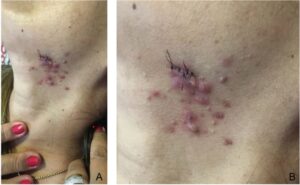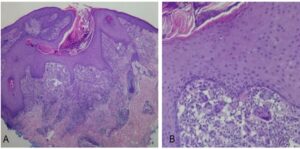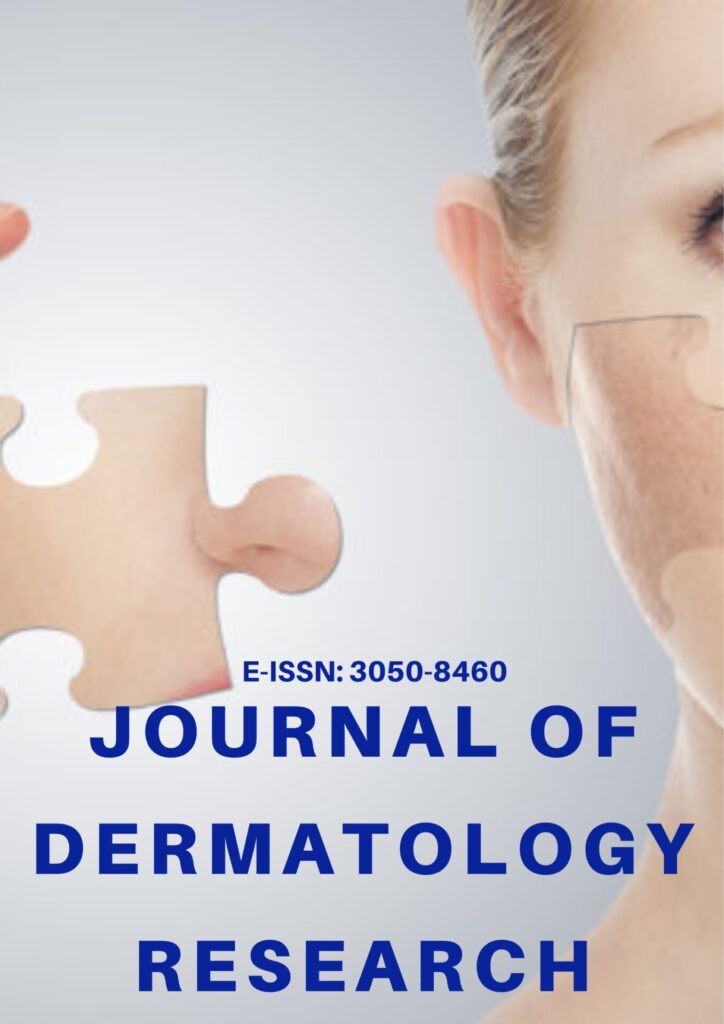Case Report | Vol. 6, Issue 1 | Journal of Dermatology Research | Open Access |
Isotopic Phenomenon: Case Report and Distinctions Between the Isomorphic Phenomenon, Inverse Isomorphic Phenomenon and the Sign of Pathergy
Larissa Maehara Kondo1, Beatriz Toyohara Yuyama2, Rogério Nabor Kondo3*
1Medical Student at the Federal Fluminense University, Rio de Janeiro, Brazil
2Medical Student at the Pontifical Catholic University of Paraná Campus Londrina, Paraná, Brazil
3Dermatologist, Assistant Professor of Dermatology of University Hospital of the State University of Londrina, Paraná, Brazil
*Correspondence author: Rogério Nabor Kondo, Dermatologist, Assistant Professor of Dermatology of University Hospital of the State University of Londrina, Paraná, Brazil; Email: [email protected]
Citation: Kondo LM, et al. Isotopic Phenomenon: Case Report and Distinctions Between the Isomorphic Phenomenon, Inverse Isomorphic Phenomenon and the Sign of Pathergy. J Dermatol Res. 2025;6(1):1-4.
Copyright© 2025 by Kondo LM, et al. All rights reserved. This is an open access article distributed under the terms of the Creative Commons Attribution License, which permits unrestricted use, distribution, and reproduction in any medium, provided the original author and source are credited.
| Received 12 January, 2025 | Accepted 28 January, 2025 | Published 06 February, 2025 |
Abstract
The isotope phenomenon, also called the Wolf’s isotopic response, refers to the emergence of a new skin disease at the exact location of a previously cured unrelated skin disease, often following infection with the herpes zoster virus. We report a case of isotopic phenomenon and provide brief comments on the distinctions between the isomorphic phenomenon, inverse isomorphic phenomenon and sign of pathergy.
Keywords: Isotopic Response; Isomorphic Response; Inverse Isomorphic Phenomenon; Herpes Zoster Infection; Pathergy
Introduction
The Wolf’s Isotopic Response (WIR), also known as isotopic response, describes the emergence of a new dermatosis at the exact site of a previously cured, unrelated skin disease. It can occur following the resolution of various skin diseases, most commonly after infection with the Herpes Zoster (HZ) vírus [1,2].
Secondary skin diseases frequently associated with WIR include inflammatory dermatoses, bacterial infections, granulomas and malignancies. Among different types of lesions, lichen planus secondary to HZ infection is the most frequently reported [2].
The distinction between WIR and the isomorphic phenomenon or Koebner’s Phenomenon (KP) is that in KP, new lesions, whether related or not, occur in healthy skin after trauma, although some authors believe that they are the same phenomenon [3,4].
This report presents a case of isotopic phenomenon and provides brief commentary on the distinctions of isomorphic phenomenon, inverse isomorphic phenomenon and the sign of pathergy.
Case Report
A 50-year-old female patient, yellow, presented papules, plaques and pustules in the left submandibular region, which were asymptomatic (Fig. 1). The lesions resembled folliculitis, but were characterized by a granulomatous reaction. The unilateral nature of the injuries drew attention, but she denied any history of contact with different substances at the site or trauma. There was a history of HZ in the same location 10 months earlier, which had been treated by the infectious disease specialist with valacyclovir, with regression of the herpetic lesions.
Case Report
A 50-year-old female patient, yellow, presented papules, plaques and pustules in the left submandibular region, which were asymptomatic (Fig. 1). The lesions resembled folliculitis, but were characterized by a granulomatous reaction. The unilateral nature of the injuries drew attention, but she denied any history of contact with different substances at the site or trauma. There was a history of HZ in the same location 10 months earlier, which had been treated by the infectious disease specialist with valacyclovir, with regression of the herpetic lesions.

Figure 1: A: Submandibular erythematous papules and plaques on the left; B: Detail of the injuries.

Figure 2: A: Panoramic image showing follicular and perifollicular inflammatory reaction (hematoxylin-eosin 10 x); B: Detail of the giant cell granuloma (hematoxylin-eosin 40 x).
Based on clinical, laboratory and anatomopathological findings, the lesions (suppurative folliculitis and suppurative granulomatous perifolliculitis) were classified as an isotopic phenomenon. There was improvement in the lesions with oral azithromycin and topical azelaic acid.
Discussion
Wolf, et al., in 1995, used the term “isotopic response”, later known as Wolf’s Isotopic Response (WIR) to describe the emergence of a new skin disease at the site of another unrelated and already cured dermatosis. Initially, it was mainly related to HZ, but nowadays WIR includes any other triggering factors, for example: appearance of lichen planus in the same location as cured cutaneous leishmaniasis [2,3]. The reason for the occurrence of WIR is not fully understood. There is a hypothesis that the dermatome, from previously cured dermatoses, is a “vulnerable and susceptible area” that can trigger an “isotopic response” more easily than another region [2]. This would explain why the lesions were unilateral in the present case.
The Köbner Phenomenon (KP) is characterized by the appearance of inflammatory or infectious dermatosis following cutaneous trauma in an area of “healthy” skin (without previous dermatosis). The most frequently affected skin conditions are psoriasis, lichen planus and vitiligo [3].
The Inverse Isomorphic Phenomenon (IIP), described by Renbok, refers to the disappearance of a previous injury after trauma, obviously unlike KP. However, IIP was not known as Renbök Phenomenon (RP), as RP had already been described for the association of psoriasis and alopecia areata on the scalp [5]. Interestingly, when we read the surname KOEBNER backwards, without the letter E between the letters O and B, we will have the surname RENBOK (KOEBNER → RENBOK), which are two similar eponyms with almost all the same letters, but in reverse order.
The Sign of Pathergy (SP) refers to the development of new identified injuries or the worsening of existing ones after common trauma. It occurs in some neutrophilic dermatoses and in Behçet’s Disease (BD) SP is better known. If BD is suspected, the test can be performed by puncturing the skin with a sterile needle (pathergy test), in which an erythematous pustule or papule appears at the punctured site (positive SP) [6]. But debridement in pyoderma gangrenosum is one of the major pathergy problems, as there is an increase in the extent and ulcer depth [7].
The trigger mechanisms (triggering factors) for each occurrence (WIR, KP, IIP, RP) or Signal (SP) are still unknown. But the place on the skin, in which manifests itself, would have a greater susceptibility to the event, which makes some authors hypothesized that they would all be the same entity [4].
In the present case, the patient improved after treatment with oral lymecycline and topical azelaic acid, but developed hyperchromic cicatricial papules, in which these residual lesions cannot be considered as WIR since they are related to granulomatous folliculitis.
Conclusion
WIR presents differences and similarities with KP. The important thing is that the dermatologist has knowledge about their definitions and also knows how to differentiate between FII, FR and SP.
Conflict of Interest
The authors declared no potential conflicts of interest with respect to the research, authorship and/or publication of this article.
Funding
This research received no specific grant from funding agencies in the public, commercial or not-for-profit sectors.
References
- Wolf R, Wolf D, Ruocco E, Brunetti G, Ruocco V. Wolf´s isotopic response. Clin Dermatol. 2011;29(2):237-40.
- Xu W, Yu C, Le Y, Zhang J. Wolf’s isotopic response after herpes zoster infection in chronic lichen sclerosus-like graft versus host disease: Case report and literature review. Clin Cosmet Investig Dermatol. 2022;15:2153-7.
- Giet G, Senterre Y, Lebas E, Libon F, Dezfoulian B, Nikkels AF. Köbner’s phenomenon in dermatology. Rev Med Liege. 2021;76(9):651-6.
- Happle R, Kluger N. Koebner’s sheep in Wolf’s clothing: does the isotopic response exist as a distinct phenomenon? J Eur Acad Dermatol Venereol. 2018;32(4):542-3.
- Ovcharenko Y, Serbina I, Zlotogorski A, Ramot Y. Renbök phenomenon in an alopecia areata patient with psoriasis. Int J Trichology. 2013;5(4):194-5.
- Kutlubay Z, Tüzün Y, Wolf R. The pathergy test as a diagnostic tool. Skinmed. 2017;15(2):97-104.
- Araújo FM, Kondo RN, Minelli L. Pioderma gangrenoso: Enxerto de pele e oxigenoterapia hiperbárica como adjuvantes no tratamento de úlcera extensa e profunda. An Bras Dermatol. 2013;88(6):S176-8.
Author Info
Larissa Maehara Kondo1, Beatriz Toyohara Yuyama2, Rogério Nabor Kondo3*
1Medical Student at the Federal Fluminense University, Rio de Janeiro, Brazil
2Medical Student at the Pontifical Catholic University of Paraná Campus Londrina, Paraná, Brazil
3Dermatologist, Assistant Professor of Dermatology of University Hospital of the State University of Londrina, Paraná, Brazil
*Correspondence author: Rogério Nabor Kondo, Dermatologist, Assistant Professor of Dermatology of University Hospital of the State University of Londrina, Paraná, Brazil;
Email: [email protected]
Copyright
Larissa Maehara Kondo1, Beatriz Toyohara Yuyama2, Rogério Nabor Kondo3*
1Medical Student at the Federal Fluminense University, Rio de Janeiro, Brazil
2Medical Student at the Pontifical Catholic University of Paraná Campus Londrina, Paraná, Brazil
3Dermatologist, Assistant Professor of Dermatology of University Hospital of the State University of Londrina, Paraná, Brazil
*Correspondence author: Rogério Nabor Kondo, Dermatologist, Assistant Professor of Dermatology of University Hospital of the State University of Londrina, Paraná, Brazil; Email: [email protected]
Copyright© 2025 by Kondo LM, et al. All rights reserved. This is an open access article distributed under the terms of the Creative Commons Attribution License, which permits unrestricted use, distribution, and reproduction in any medium, provided the original author and source are credited.
Citation
Citation: Kondo LM, et al. Isotopic Phenomenon: Case Report and Distinctions Between the Isomorphic Phenomenon, Inverse Isomorphic Phenomenon and the Sign of Pathergy. J Dermatol Res. 2025;6(1):1-4.



